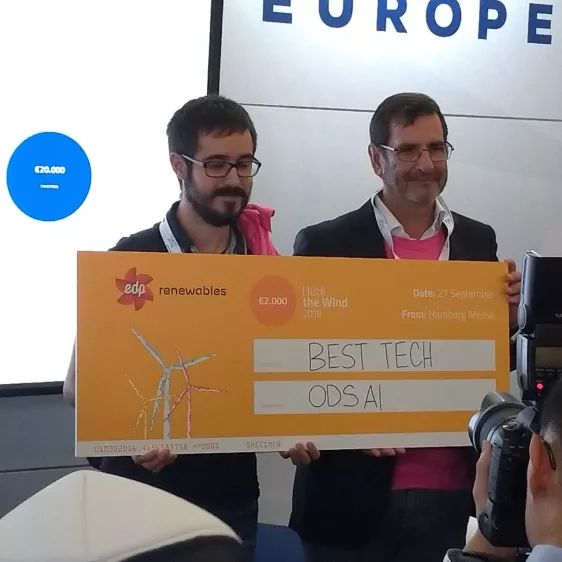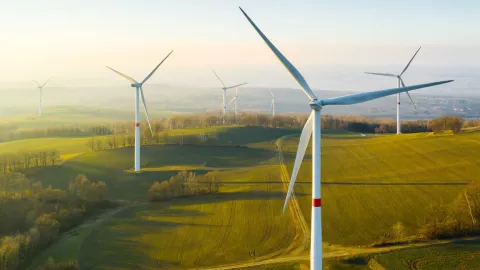HTW 2018: Wind Turbine Failures Detection
Completed competition
- Deadline: 10:00 AM (CET) Sep 27 th , 2018
- Grand Prize: 5k€ for the winning team of EDP’s challenge
- Best Technical Solution: 2k€ for the team with the best algorithm results
Description
Time is money and anticipating failures in wind turbines can reduce the time spent on maintenance and the decrease of production due to unavailability - paving the way for lower levelized costs of clean energy. How many failures can you anticipate? We challenge you to develop a global solution for this problem, focusing on prediction capabilities to detect early stage failures and, consequently, reduce maintenance’s costs. The components to be monitored will be:
- Gearbox
- Generator
- Generator Bearing
- Transformer
- Hydraulic Group
We provide 2 years of SCADA records from 5 wind turbines and from the meteorological mast to create, train and test your models. We also include 1 year of previously detected failures.
Rules
Here, we ask you to put your predictive skills to the test! The goal of this data challenge is to foster new innovative and reliable predictive maintenance strategies that avoid large correctives from happening, in order to foresight and minimize the asset downtime and decrease the associated costs.
Most relevant Rules:
Submission Deadline: 10:00 AM September 27 th , 2018;
- Prize:
- 5 000 € for the team with the best global solution;
- 2 000 € for the team with the best technical solution;
The team who wins the Grand Prize is not eligible to win the Best Technical Solution Prize.
- Eligibility:
- Who is registered in the Competition;
- Who is older than the required legal age by law in their country of residence to enter this competition;
- Who holds a bank account in their country of tax residence;
- Who has IT skills, technical skills, design skills, or marketing skills; and
- Who has their own computer hardware in working order during all the duration of the Competition.
To be eligible to win the Challenge, the participants must also be present during the submission of their team's prototype, or -if needed be- be excused by the other members of their team.
External datasets: Only the datasets provided should be required to the solution.
Challenge Evaluation
This challenge is integrated in Hack The Wind 2018, so we want to challenge you to develop more than just a simple predictive algorithm. We are looking for a global solution, not only focused on your predictive skills, but also on the whole business case and how well you pitch your solution.
The evaluation will be divided in two moments:
- The first phase is a science fair judgings, in which a mentor's judging team will meet individually the teams, listen to their pitches and designate the finalists. In this phase, you will be scored according to the following criteria: 35% judge opinion; 65% algorithm results.
- In the second phase, each finalist team will present its prototype to the jury. In this phase, you will be scored according to the following criteria: 40% algorithm results; 25% pitch; 20% UI/UX design; 15% business case.
Prize pool:
According to the aforementioned criteria, we will have 2 teams awarded as follows:
- Grand Prize of 5000 € for the team with the best global solution, i.e. the team with the highest score in all the components of the evaluation criteria of Phase 2.
- Best Technical Solution of 2000 € for the team with the highest score in "Algorithm Results" component of the evaluation criteria of Phase 2
The team who wins the Grand Prize is not eligible to win the Best Technical Solution Prize.
To see how the algorithm is evaluated consult the tab "Algorithm Evaluation".
Algorithm Evaluation
Regarding to the predictive algorithm, submissions will be ranked based on the Total Prediction Savings, i.e. the capacity of reducing maintenance costs (including preventive and corrective).
Your predictions can be classified as either:
- True positives (TP) are failures of the correct wind turbine and subsystem, detected between 2 and 60 days before the date of the break. If a failure is detected in the right period but in the wrong wind turbine or subsystem, it counts as a false positive. True Positives are translated into savings, which are the difference between replacement and repair costs.

- False negatives (FN) are real failures in a wind turbine and subsystem where there is no detection in the previous 2-60 days. False negatives are translated into replacement costs.

- False positives (FP) are detections in a wind turbine and subsystem where there is no failure in the next 2-60 days.False positives are translated into inspection costs.

According to the previous classification, your predictions will imply Replacement Costs (RP), Repair Costs (RC) or Inspection Costs (IC). For each component, RP, RC and IC are given in the table below:
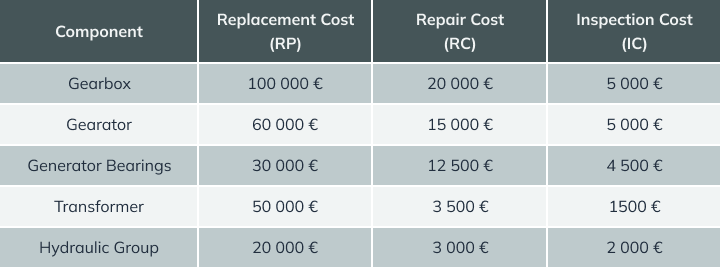
Based on your predictions and associated costs, the Total Prediction Savings are calculated accounting all the 5 components and 5 wind turbines, according to the following metric:
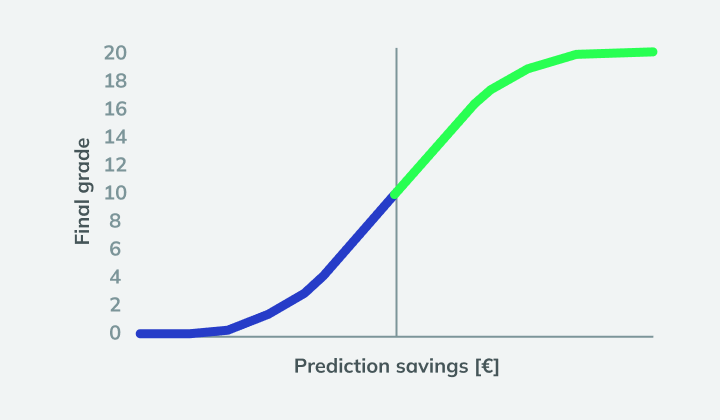
Grade system:
Based on the cost savings allowed by the predictive maintenance algorithm, your results will be graded between 0 and 20, using an undisclosed sigmoidal activation function, as follows:
- Positive Prediction Savings (Green part of the curve) means that your model allowed savings and you have a positive grade (>10).
- Negative Prediction Savings (Blue part of the curve) means that your model resulted in added expenses and you have a negative grade (< 10).
- Null Prediction Savings means the additional expense due to faulty predictions is compensated by the additional savings due to accurate predictions and your grade is 10.
Winner Grand Prize
Alpha-I Testimony and Approach
"For Alpha-I, HTW 2018 was a great learning experience both in terms of technology and domain knowledge. Moreover, it was 48 hours of non-stop data analysis and an opportunity to interact with new people in the industry. The EDP Renewables team was very supportive and helped us a lot in understanding the data. During the hackathon, Alpha-I evaluated a two-fold approach. Firstly, the statistical properties of the SCADA data were analyzed to formalize rules for detecting anomalies. However, lack of enough fault data made it difficult to train our machine learning models. Secondly, using our visualization platform, we looked for apparent visual signals prior to a fault (as per the list of faults in 2016). Using domain knowledge, some of the faults could be easily detected well in advance using just visual signals characteristic to those faults. In conclusion, we found that data visualization and domain knowledge can help label turbine data to make machine learning more effective."
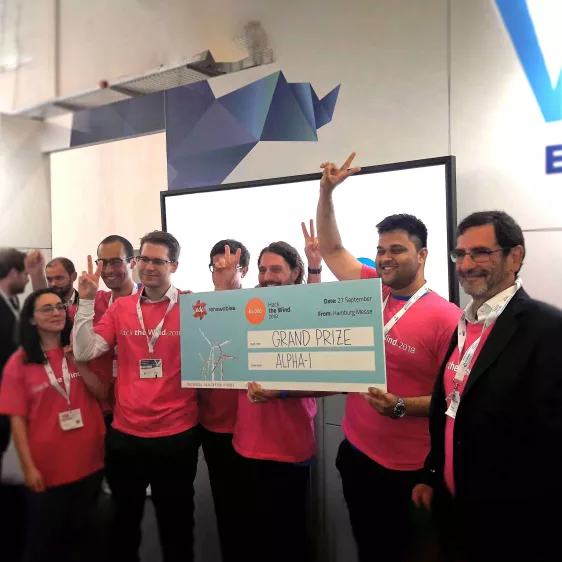
Winner Best Technical Solution
ODS-AI Testimony and Approach
"During the hackathon ODS AI team had a great opportunity to explore the specifics of working with data in wind energy domain. In combination with the interesting task in the area of machine learning, it was a great experience. First step was the preprocessing of the dataset. Missing values were filled by interpolation of neighbors and each feature was normalized within given turbine. During the initial research it became clear that the state-of-art solutions are usually based on Long Short-Term Memory networks. However, for the given conditions this approach was ineffective due to the limited time for training and the size of the dataset. As an alternative the one-dimensional convolutional neural network with 10 days moving window was used. To overcome the problem of limited dataset, data augmentation was used. This approach proved to be efficient but also had many false-positive results and was unable to predict failures of the generator bearing."
